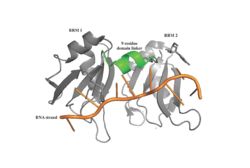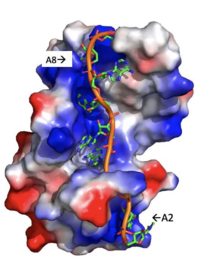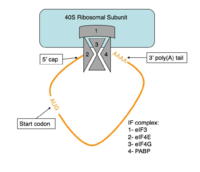Poly(A) binding protein
From Proteopedia
(Difference between revisions)
| Line 9: | Line 9: | ||
[[Image: PABP Biological Assembly 1.jpg |250 px|left|thumb|Figure 1: PABP Biological Assembly with linker highlighted. ]] | [[Image: PABP Biological Assembly 1.jpg |250 px|left|thumb|Figure 1: PABP Biological Assembly with linker highlighted. ]] | ||
| - | Human Poly(A) Binding Protein (PABP) is a biopolypeptide involved in recognizing the [https://en.wikipedia.org/wiki/Polyadenylation 3' poly(A) tail] of [https://en.wikipedia.org/wiki/Messenger_RNA mRNA] that is added to an mRNA transcript during mRNA processing.This recognition as well as PABP's interaction with other proteins and [https://en.wikipedia.org/wiki/Initiation_factor initiation factors] causes it to also play a significant role in [https://en.wikipedia.org/wiki/Eukaryotic_translation translation] initiation and mRNA stabilization and degradation. PABP consists of four conserved [https://en.wikipedia.org/wiki/Protein_domain domains] of [https://en.wikipedia.org/wiki/RNA_recognition_motif RNA recognition motifs] (RRMs); however, the two [https://en.wikipedia.org/wiki/N-terminus N-terminal] RRMs (RRM1 and RRM2) and the short linker sequence that connects them supports most of the function of PABP, so | + | Human Poly(A) Binding Protein (PABP) is a biopolypeptide involved in recognizing the [https://en.wikipedia.org/wiki/Polyadenylation 3' poly(A) tail] of [https://en.wikipedia.org/wiki/Messenger_RNA mRNA] that is added to an mRNA transcript during mRNA processing.This recognition as well as PABP's interaction with other proteins and [https://en.wikipedia.org/wiki/Initiation_factor initiation factors] causes it to also play a significant role in [https://en.wikipedia.org/wiki/Eukaryotic_translation translation] initiation and mRNA stabilization and degradation. PABP consists of four conserved [https://en.wikipedia.org/wiki/Protein_domain domains] of [https://en.wikipedia.org/wiki/RNA_recognition_motif RNA recognition motifs] (RRMs); however, the two [https://en.wikipedia.org/wiki/N-terminus N-terminal] RRMs (RRM1 and RRM2) and the short linker sequence that connects them supports most of the function of full-length PABP, so due to this and the modular organization of the protein, it is thought that the full complement of PABP may not be essential. Thus, the published [https://en.wikipedia.org/wiki/X-ray_scattering_techniques X-ray diffraction] structure, exhibits RRM1 and RRM2 at a 2.6 Angstrom [https://en.wikipedia.org/wiki/Resolution_(electron_density) resolution]. This is shown as <scene name='78/781947/Biological_assembly_1/1'>Biological Assembly 1</scene>. Both RRM 1 and 2 are needed to support biochemical function, that is, no one RRM can support biochemical function. Additionally, there is a [https://en.wikipedia.org/wiki/Proline proline] rich [https://en.wikipedia.org/wiki/C-terminus C-terminal] portion of variable length that is not well conserved and unknown as to how it contributes to the protein's function <ref name= "PABP"> Deo, Rahul C, et al. “Recognition of Polyadenylate RNA by the Poly(A)-Binding Protein.” Cell, vol. 98, no. 6, 1999, pp. 835–845., doi:10.1016/s0092-8674(00)81517-2.</ref>. |
== Function and Structure == | == Function and Structure == | ||
| Line 16: | Line 16: | ||
[[Image: Screen_Shot_2018-03-29_at_12.18.14_AM.png|250 px|left|thumb|Figure 2: The specific weak intermolecular interactions between RNP1 and RNP2 and Adenosines. These interactions are the primary support of adenosine recognition by PABP and include mainly van der Waals interactions, hydrogen bonds, and stacking interactions. ]] | [[Image: Screen_Shot_2018-03-29_at_12.18.14_AM.png|250 px|left|thumb|Figure 2: The specific weak intermolecular interactions between RNP1 and RNP2 and Adenosines. These interactions are the primary support of adenosine recognition by PABP and include mainly van der Waals interactions, hydrogen bonds, and stacking interactions. ]] | ||
| - | A primary function of PABP is recognizing and interacting with the 3'poly (A) tail created in mRNA processing. As found by [https://en.wikipedia.org/wiki/Electrophoretic_mobility_shift_assay EMSA competition experiments], there is a minimum of 11-12 adenosines necessary in the poly (A) tail for the adenosine chain to bind to PABP with high affinity. However, for one biological assembly, a chain containing 9 adenosines sufficiently binds the assembly for [https://en.wikipedia.org/wiki/Crystallization crystallization] and is shown in the biological assembly structure. The 4 RRM domains that are the primary interacting sites for the adenosine recognition exist as globular domains, each having four antiparallel [https://en.wikipedia.org/wiki/Beta_sheet β-strands] and two [https://en.wikipedia.org/wiki/Alpha_helix α-helices]. With the N-terminal to C-terminal motifs labeled as S1 to S4 for the β-strands and H1 to H2 for the α-helices, the strands are spatially arranged as S2-S3-S1-S4. Furthermore, there are two [https://en.wikipedia.org/wiki/Conserved_sequence conserved sequences] in each RRM, called RNP1 and 2. RNP 1 consists of a conserved sequence of 8 [https://en.wikipedia.org/wiki/Residue residues], while RNP2 consists of a conserved sequence of 6 residues. Much of the weak [https://en.wikipedia.org/wiki/Intermolecular_force intermolecular interactions] with [https://en.wikipedia.org/wiki/Adenosine adenosine] from the RRMs occur from the <scene name='78/781946/Rnp_1_rnp2/1'>RNP 1 and RNP 2</scene> conserved sequences, which correspond to the two central β-strands, with specific interactions shown in Figure 2.The support for adenosine recognition by the RRMs occurs as a type of binding trough with the sheets, primarily <scene name='78/781946/Rnp_1_rnp2/1'>RNP 1 and RNP 2</scene> forming the base of the primary binding trough, and the interstrand loop between β-strands 2 and 3 as well as the domain linker forming the <scene name='78/781947/Adenosine_binding_wall/1'>Adenosine Binding Wall</scene>. It is believed that the <scene name='78/781946/Pabp_linker_conserved_residues/1'>Conserved Linker Shown</scene> is disordered in the absence of RNA because it does not intramolecularly interact with either of the RRM motifs. Additionally, the primary binding trough is stabilized by <scene name='78/781947/Rrm1_2_packing_intxn/3'>Stabilizing Packing Interactions of RRM1 RRM2 Binding Trough</scene>. <ref name= "PABP"/> | + | A primary function of PABP is recognizing and interacting with the 3'poly (A) tail created in mRNA processing. As found by [https://en.wikipedia.org/wiki/Electrophoretic_mobility_shift_assay EMSA competition experiments], there is a minimum of 11-12 adenosines necessary in the poly (A) tail for the adenosine chain to bind to PABP with high affinity. However, for one biological assembly, a chain containing 9 adenosines sufficiently binds the assembly for [https://en.wikipedia.org/wiki/Crystallization crystallization] and is shown in the biological assembly structure. The 4 RRM domains that are the primary interacting sites for the adenosine recognition exist as globular domains, each having four antiparallel [https://en.wikipedia.org/wiki/Beta_sheet β-strands] and two [https://en.wikipedia.org/wiki/Alpha_helix α-helices]. With the N-terminal to C-terminal motifs labeled as S1 to S4 for the β-strands and H1 to H2 for the α-helices, the strands are spatially arranged as S2-S3-S1-S4. Furthermore, there are two [https://en.wikipedia.org/wiki/Conserved_sequence conserved sequences] in each RRM, called RNP1 and 2. RNP 1 consists of a conserved sequence of 8 [https://en.wikipedia.org/wiki/Residue residues], while RNP2 consists of a conserved sequence of 6 residues. Much of the weak [https://en.wikipedia.org/wiki/Intermolecular_force intermolecular interactions] with [https://en.wikipedia.org/wiki/Adenosine adenosine] from the RRMs occur from the <scene name='78/781946/Rnp_1_rnp2/1'>RNP 1 and RNP 2</scene> conserved sequences, which correspond to the two central β-strands, with specific interactions shown in Figure 2.The support for adenosine recognition by the RRMs occurs as a type of binding trough with the sheets, primarily <scene name='78/781946/Rnp_1_rnp2/1'>RNP 1 and RNP 2</scene> forming the base of the primary binding trough, and the interstrand loop between β-strands 2 and 3 as well as the domain linker forming the <scene name='78/781947/Adenosine_binding_wall/1'>Adenosine Binding Wall</scene>. It is believed that the <scene name='78/781946/Pabp_linker_conserved_residues/1'>Conserved Linker Shown</scene> is disordered in the absence of RNA because it does not intramolecularly interact with either of the RRM motifs, and instead only interacts with the RNA such as with Arg 94 exhibiting pi-stacking with adenine 6 and side chain hydrophobic interactions with adenine 5. Additionally, the primary binding trough is stabilized by <scene name='78/781947/Rrm1_2_packing_intxn/3'>Stabilizing Packing Interactions of RRM1 RRM2 Binding Trough</scene>. <ref name= "PABP"/> |
[[Image: Adenosine_backbone.png |200 px|right|thumb|Figure 3: Basic residues of RRM 1 and 2 (shown in blue) make stabilizing electrostatic interactions with the negatively charged adenosine phosphates. ]] | [[Image: Adenosine_backbone.png |200 px|right|thumb|Figure 3: Basic residues of RRM 1 and 2 (shown in blue) make stabilizing electrostatic interactions with the negatively charged adenosine phosphates. ]] | ||
Revision as of 16:24, 17 April 2018
Poly(A) binding protein
| |||||||||||




